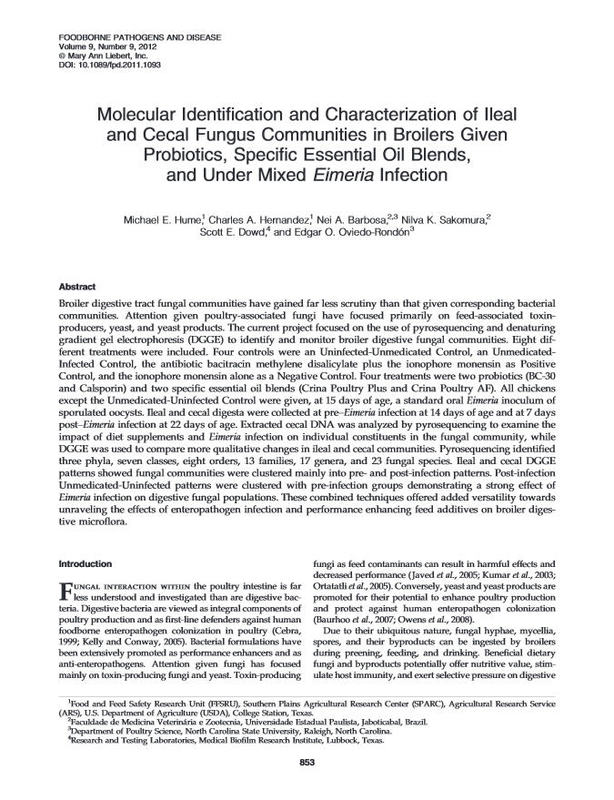Molecular identification and characterization of ileal and cecal fungus communities in broilers given probiotics, specific essential oil blends, and under mixed Eimeria infection
Title
Molecular identification and characterization of ileal and cecal fungus communities in broilers given probiotics, specific essential oil blends, and under mixed Eimeria infection
Creator
Date
Subject
Excerpt
Broiler digestive tract fungal communities have gained far less scrutiny than that given corresponding bacterial communities. Attention given poultry-associated fungi have focused primarily on feed-associated toxinproducers, yeast, and yeast products. The current project focused on the use of pyrosequencing and denaturing gradient gel electrophoresis (DGGE) to identify and monitor broiler digestive fungal communities. Eight different treatments were included. Four controls were an Uninfected-Unmedicated Control, an Unmedicated-Infected Control, the antibiotic bacitracin methylene disalicylate plus the ionophore monensin as Positive Control, and the ionophore monensin alone as a Negative Control. Four treatments were two probiotics (BC-30 and Calsporin) and two specific essential oil blends (Crina Poultry Plus and Crina Poultry AF). All chickens except the Unmedicated-Uninfected Control were given, at 15 days of age, a standard oral Eimeria inoculum of sporulated oocysts. Ileal and cecal digesta were collected at pre–Eimeria infection at 14 days of age and at 7 days post–Eimeria infection at 22 days of age. Extracted cecal DNA was analyzed by pyrosequencing to examine the impact of diet supplements and Eimeria infection on individual constituents in the fungal community, while DGGE was used to compare more qualitative changes in ileal and cecal communities. Pyrosequencing identified three phyla, seven classes, eight orders, 13 families, 17 genera, and 23 fungal species. Ileal and cecal DGGE patterns showed fungal communities were clustered mainly into pre- and post-infection patterns. Post-infection Unmedicated-Uninfected patterns were clustered with pre-infection groups demonstrating a strong effect of Eimeria infection on digestive fungal populations. These combined techniques offered added versatility towards unraveling the effects of enteropathogen infection and performance enhancing feed additives on broiler digestive microflora.
Relation
Foodborne Pathogens and Disease
Volume 9, Number 9
p. 853-860
 An official website of the United States government.
An official website of the United States government.


